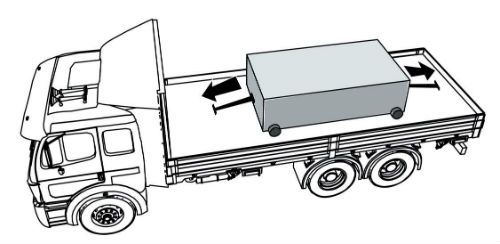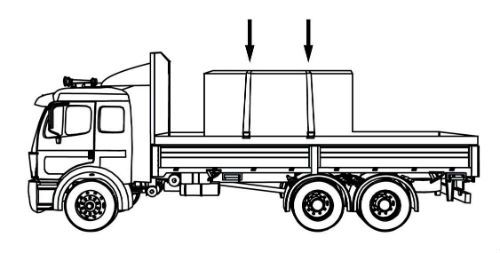CDL Practice Tests: Flatbed Cargo Securement
Choose A Section:
Go!A stack of shortwood loaded lengthwise can be secured with one tiedown if:
- They are blocked in the front by a headboard or another stack of logs.
- All logs in the stack are less than 10 ft long.
- All of these apply.
- They are blocked in the back by the vehicle's end structure or another stack of logs.
One tiedown
A stack can be secured with one tiedown if all logs in the stack less than 3.04 m (10 ft) are:
- Blocked in the front by a headboard strong enough to restrain the load or by another stack of logs.
- Blocked in the rear by the vehicle's end structure or another stack of logs.
Securing heavy vehicles or equipment with crawler tracks or wheel requires a minimum of how many tiedowns?
- 6
- 4
- 2
- It depends on the weight of the load
Special Circumstances: Securing Heavy Vehicles, Equipment, or Machinery with Crawler Tracks or Wheels
Tiedown requirements
- Restrain cargo using a minimum of four tiedowns, each having a WLL of at least 2,268 kg (5,000 lb.).
- Prevents cargo movement in the side-to-side, forward, rearward, and vertical directions.
-
Attach tiedowns:
- Either at the front and rear of the vehicle.
- Or at the mounting points on the vehicle designed for that purpose.
What is a rub rail?
- A rail along the side of a vehicle that protects the side of the vehicle from impacts.
- A strip of material that may be used to unitize articles and is tensioned and clamped or crimped back upon itself. (same as "Strapping")
- A platform or tray on which cargo is placed so that it can be handled as an article. (Same as "Skid")
- A device placed between the deck of a vehicle and car or between articles of cargo, intended to provide greater friction than exists naturally between these surfaces.
Rub Rail:
A rail along the side of a vehicle that protects the side of the vehicle from impacts.
When securing metal coils in a sided vehicle without anchor points:
- Use friction mats
- All of these apply
- Follow general cargo securement requirements
- Use locking and bracing
Securing Coils Transported in a Sided Vehicle or Intermodal Container without Anchor Points
To prevent metal coils from moving horizontally and/or tipping:
Follow general cargo securement requirements
Secure the coils using:
- Blocking and bracing
- Friction mats
- A combination of these.
What is the minimum amount of rearward force that a cargo securement system must withstand?
- 20% of cargo weight
- 50% of cargo weight
- 100% of cargo weight
- 80% of cargo weight
Each cargo securement system must be able to withstand a minimum amount of force in each direction.
- Forward Force = 80% of cargo weight when braking while driving straight ahead.
- Rearward Force = 50% of cargo weight when accelerating, shifting gears while climbing a hill, or braking in reverse.
- Sideways Force = 50% of cargo weight when turning, changing lanes, or braking while turning.
-
Upward Force = 20% of cargo weight when traveling over bumps in the road or cresting a hill.
- This requirement is satisfied when the cargo is "Fully Contained."
When securing a paper roll with a width that is more than twice its diameter, which of the following is not an acceptable method of securement to prevent tipping?
- Band the roll to other rolls.
- Brace it.
- Use rear doors to brace it.
- Use tiedowns.
Situation #1:
- Paper roll is not prevented from tipping by the vehicle structure or other cargo.
- Paper roll width is more than 2 times its diameter.
Solution #1:

- Either band the roll to other rolls.
- Or brace it.
- Or use tiedowns.
What is a headboard?
- A vertical barrier across a vehicle to prevent forward movement of cargo.
- A vertical barrier across the front of the deck of a vehicle to prevent forward movement of cargo.
- A transverse load bearing structural component, particularly a part of a log bunk.
- A vertical barrier placed directly behind the cab of a tractor to protect the cab in the event cargo should shift forward.
Headboard:
A vertical barrier across the front of the deck of a vehicle to prevent forward movement of cargo.
Concrete pipe loaded crosswise generally:
- Concrete pipe with an inside diameter up to 1.143 m (45 in) can form a complete single tier on a typical flatbed vehicle. Larger pipe often can only be carried as a partial tier.
- At least one tiedown through the rear pipe of the bottom tier must run forward at an angle not more than 45 with the horizontal when viewed from the side of the vehicle, when ever practical.
- Note: At least one tiedown through the front pipe of the bottom tier must run rearward at an angle not more than 45 with the horizontal when viewed from the side of the vehicle, when ever practical.
- All of these things apply.
Special Circumstances: Securing Pipe with an Inside Diameter Up to 1.143 mm (45 in)
Concrete pipe with an inside diameter up to 1.143 m (45 in) can form a complete single tier on a typical flatbed vehicle. Larger pipe often can only be carried as a partial tier.
Note: This pipe diameter of 1.143 m (45 in) is simply a convenient breaking point between "medium" and "large" diameter pipe.
Note: At least one tiedown through the front pipe of the bottom tier must run rearward at an angle not more than 45 with the horizontal when viewed from the side of the vehicle, when ever practical.
At least one tiedown through the rear pipe of the bottom tier must run forward at an angle not more than 45 with the horizontal when viewed from the side of the vehicle, when ever practical.
All of the following are requirements for dividing vehicles over 33ft except:
- Each tiedown must secure the highest log on each side of the center stake.
- Vehicle must be divided by center stakes into sections of staggered length.
- Each tiedown must be fastened below the logs on each side of the center stake.
- Vehicle must be equipped with center stakes or comparable devices.
Requirements for dividing vehicles over 10m (33 ft)
Vehicles over 10 m (33 ft) must be equipped with center stakes, or comparable devices, to divide it into sections of equal length.
Each tiedown must:
- Secure the highest log on each side of the center stake.
- Be fastened below these logs.
What is the minimum securement requirement for paper rolls with eyes vertical with a width between 1.25 and 1.76 its diameter?
- Friction mats alone.
- Banding them together.
- All of these are required.
- Tiedowns.
Situation #4
- A paper roll or the forwardmost roll(s) in a group of paper rolls is not prevented from tipping or falling forward by vehicle structure or other cargo.
- Paper roll width is more than 1.25 times and less than 1.76 times its diameter.
- Only friction mats are used for forward securement.
Solution #4:
The friction mat alone is adequate. The friction mat allows the roll to slide on the floor without tripping the roll.
About The Flatbed Cargo Securement CDL Manual
Studying the flatbed cargo securement CDL manual is not a requirement for getting your CDL permit or license. It is required knowledge for flatbed drivers.
Some questions you should be able to answer for flatbed cargo securement:
- What is the minimum Working Load Limit of a tiedown used to secure logs?
- What is the minimum weight of a shipment of paper rolls that would require specific securement requirements?
- When securing concrete pipe over 45 inches loaded crosswise, which direction must the tiedowns on the front half of the load run?
- What is a cab shield?
- When securing concrete pipe over 45 inches loaded crosswise, which direction must the tiedowns on the rear half of the load run?
- What is a dunnage bag?
- Who is responsible for inspecting securing devices and cargo within the first 50 miles?
- How many tiedowns are required on a stack of shortwood loaded crosswise?
- What is the minimum working load limit of each tiedown used to secure crushed or flattened vehicles?
- Define 'bolster'
- What is a hook-lift container?
- When a tiedown is attached directly to the cargo, what is the ideal angle where it attached to the vehicle?
What is a securing device?
Any device specifically manufactured to attach or secure cargo to a vehicle or trailer:
- Synthetic Webbing
- Chain
- Wire rope
- Manila rope
- Synthetic rope
- Steel strapping
- Clamps and latches
- Blocking
- Front-end structure
- Grab hooks
- Binders
- Shackles
- Winches
- Stake pockets
- D-rings
- Webbing ratchet
- Bracing
- Friction mat
What is a tiedown?
A combination of securing devices that forms an assembly that:
- Attaches cargo to, or restrains cargo on a vehicle.
- Is attached to anchor point(s).

Some tiedowns are attached to the cargo and provide direct resistance to restrain the cargo from movement.

Some tie-downs pass over or through the cargo. They create a downward force that increases the effect of friction between the cargo and the deck. This friction restrains the cargo.
 Related Cargo Securement Terms That Every Driver Should Know:
Related Cargo Securement Terms That Every Driver Should Know:
-
Tiedown:
A combination of securing devices which form an assembly that attaches cargo to, or restrains cargo on, a vehicle or trailer, and is attached to anchor point(s).
-
Contained:
Cargo is contained if it fills a sided vehicle, and every article is in contact with or sufficiently close to a wall or other articles so that it cannot shift or tip if those other articles are also unable to shift or tip.
-
Blocking:
A structure, device, or another substantial article placed against or around an article to prevent horizontal movement of the article.
How should tiedowns be attached?
Tiedowns can be used in two ways:
-
Attached to the cargo:
- Tiedowns attached to the vehicle and attached to the cargo.
- Tiedowns attached to the vehicle, pass through or aroundan article of cargo, and then are attached to the vehicle again.
-
Pass over the cargo:
- Tiedowns attached to the vehicle, passed over the cargo, and then attached to the vehicle again.
Tiedown placement:

Place the tiedown as close as possible to the spacer.
Position the tiedowns as symetrically as possible over the length of the article.

Position the tiedowns to preserve the integrity of the article.







 TT On Facebook
TT On Facebook